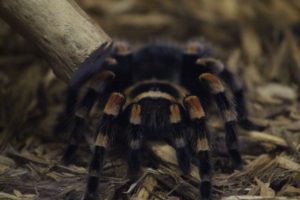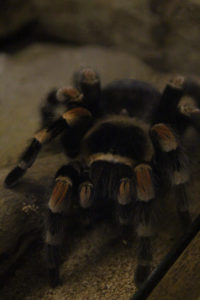MEXICAN RED-KNEE TARANTULABrachypelma smithi
Conservation Status: Lower Risk / Near Threatened
Habitat loss and the pet trade (prior to 1985, it was collected in thousands).

Learn More
Color:
It has a dark brown body and legs, with orange-red leg joints. On top of the carapace, there are 8 eyes (but they have poor vision). They have 2 spinnerets at the end of their abdomen.
Size:
12.7-14 cm in length. Females are larger than males
Weight:
15-16 grams
Average Lifespan:
Females can live up to 25-30 years old. Males only live about 1 year after maturity
Captive Lifespan:
Males mature at 4 years, while females mature around 6-7 years old.
Central Pacific coast of Mexico and inland to the states of Mexico and Morelos
This tarantula lives in the desert, scrubland, dry thorn forest, and tropical deciduous forests. They prefer burrows or rocky areas under vegetation.
Mating:
They mate in the summer and mating occurs in or near a female’s burrow. Sometimes, the females will kill and eat the males after mating.
Gestation/Incubation:
Eggs are stored in the female’s abdomen until spring.
Litter/Clutch Size:
Hundreds of eggs that are placed in a silk mat, or egg sac.
Mature:
Males mature at 4 years, while females mature around 6-7 years old.
The Mexican red knee tarantula is carnivorous and eats insects, small frogs, lizards, and mice.
They are ambush predators that hunt at night. When threatened, they will kick hairs off their abdomen with their legs. This can cause blindness if the hairs get into the eyes of a predator.
1. This tarantula is typically used in movies due to its size and appearance.
2. They have areas on their legs that can be used to smell, sense vibrations, and taste.
3. Venom has 2 purposes: to kill prey and to begin digestion.
4. They are commonly kept as pets.
5. They are parasitized by pepsis wasps, which will paralyze the tarantula and lay their eggs in the body. When the larvae hatch, they will eat the tarantula.


